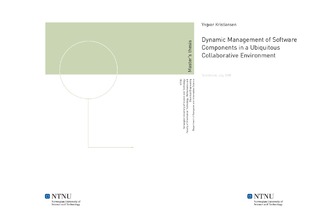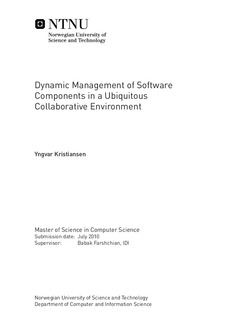| dc.contributor.advisor | Farshchian, Babak | nb_NO |
| dc.contributor.author | Kristiansen, Yngvar | nb_NO |
| dc.date.accessioned | 2014-12-19T13:35:54Z | |
| dc.date.available | 2014-12-19T13:35:54Z | |
| dc.date.created | 2010-09-16 | nb_NO |
| dc.date.issued | 2010 | nb_NO |
| dc.identifier | 351908 | nb_NO |
| dc.identifier | ntnudaim:5464 | nb_NO |
| dc.identifier.uri | http://hdl.handle.net/11250/252114 | |
| dc.description.abstract | The key motivation of this thesis is to find innovative solutions for facilitating the deployment of ubiquitous systems, with the purpose of making technology supported collaboration an easier task. Users, being in a ubiquitous environment, continuously encounter new resources that might provide some value. As the number of these resources increase, the management of them will be a central task in a ubiquitous computing system. The problems and challenges discussed in this thesis are related to continuous and unpredictable changes in the ubiquitous environment, which makes it difficult for users to retrieve appropriate software for utilizing resources. We also discuss the challenge of managing resources, and sharing them between users. The research questions in this thesis are: RQ-1: How can we extend existing service management architectures to support user-centered and community-based service management? RQ-2: What technologies, architectures and platforms are the most suitable for implementing user-centered and community-based service management? RQ-3: How can we evaluate the usability and utility of user-centered and community-based service management? What are the most compelling scenarios? The contributions in this thesis are, correspondingly: C1: We have made a solution proposal and an implementation of an improved service management system, which is based on earlier works of the Ubicollab platform. C2: Four items were found suitable: 1. The deployment model used by distribution platforms for mobile applications (such as AppStore and Android Market), 2. OSGi, 3. R-OSGi, and 4. HTTP-based communication using Java Servlets. C3: The evaluation of such systems can be done using a three-step process that includes: 1. Examining the system's fulfillment its requirement specification. 2. Compare the system's functionality with that of a scenario-described ideal system. 3. Create applications that demonstrate the utility of the system. | nb_NO |
| dc.language | eng | nb_NO |
| dc.publisher | Institutt for datateknikk og informasjonsvitenskap | nb_NO |
| dc.subject | ntnudaim | no_NO |
| dc.subject | SIF2 datateknikk | no_NO |
| dc.subject | Program- og informasjonssystemer | no_NO |
| dc.title | Dynamic Management of Software Components in a Ubiquitous Collaborative Environment | nb_NO |
| dc.type | Master thesis | nb_NO |
| dc.source.pagenumber | 124 | nb_NO |
| dc.contributor.department | Norges teknisk-naturvitenskapelige universitet, Fakultet for informasjonsteknologi, matematikk og elektroteknikk, Institutt for datateknikk og informasjonsvitenskap | nb_NO |

